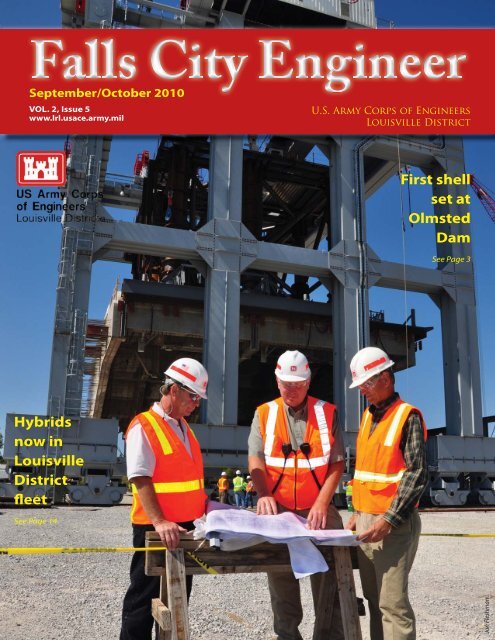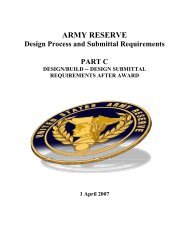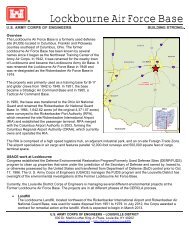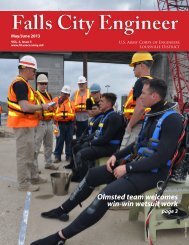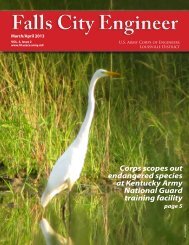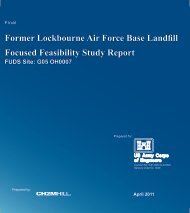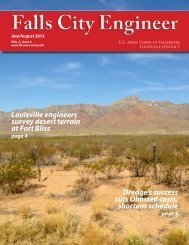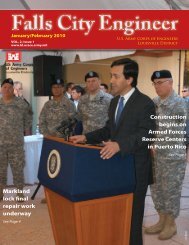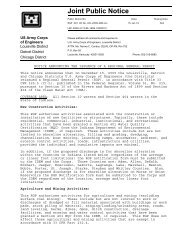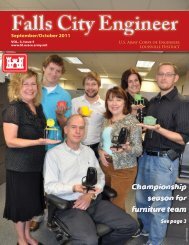September/October 2010 - Louisville District - U.S. Army
September/October 2010 - Louisville District - U.S. Army
September/October 2010 - Louisville District - U.S. Army
You also want an ePaper? Increase the reach of your titles
YUMPU automatically turns print PDFs into web optimized ePapers that Google loves.
<strong>September</strong>/<strong>October</strong> <strong>2010</strong>VOL. 2, Issue 5www.lrl.usace.army.milU.S. <strong>Army</strong> Corps of Engineers<strong>Louisville</strong> <strong>District</strong>First shellset atOlmstedDamSee Page 3Hybridsnow in<strong>Louisville</strong><strong>District</strong>fleetSee Page 14BUILDING STRONG® Volume 2, Issue 5 1Jon Fleshman
Commander’s CommentsTeam,FY 10 was a GREAT year! You continueto deliver superior performance, setstandards and make significant contributionsto our profession and nation. A fewexamples...Superior performance:• <strong>2010</strong> U.S. Air Force Civilian ProjectManager of the Year: DeweyRissler.• Lester Washington was awarded acertificate of appreciation for patrioticcivilian service for rescuingthree children, their mother, and hiswife from a burning building.• Set the first dam shell in the OhioRiver to keep the project on schedule.Make a significant contribution:• Delivered 24 BRAC projects valuedat more than $495 million and delivered15 MILCON projects worthmore than $97 million.• 100 percent ARRA obligations —$97 million to civil works projectsand $129 million to militaryprojects• Delivered the USTRANSCOMHeadquarters at Scott Air ForceBase and the Human Resource Cen-ter of Excellence at Fort Knox on orahead of schedule.Set standards in our profession:• Awarded more than $641 million incontracts to small businesses settinga new district record — that’s morethan 50 percent of the district’s totalFY10 program, and we exceededevery USACE small business categorygoal.• LRL’s construction divisionexceeded $1.5 billion for constructionplacement also setting a newdistrict record.As we move into FY11, I ask you tofind ways to execute your programs betterthis year than last while you strengthenour people and improve our processes.Our goal is to deliver our projects andservices to satisfied customers. Of note,we must keep the remaining 78 BRACprojects and Olmsted Locks and Damconstruction on track.Thank you for all you do to burnish thereputation of the <strong>Louisville</strong> <strong>District</strong> as wemake that climb from good to great.Thanks again,Col. Keith LandryCol. Keith Landry, Ph.D., P.E.Commander and <strong>District</strong> Engineer<strong>Louisville</strong> <strong>District</strong>U.S. <strong>Army</strong> Corps of Engineers<strong>Army</strong> photo digitally enhancedFalls City EngineerVol. 2, Issue 5<strong>Louisville</strong> <strong>District</strong> CommanderCol. Keith A. LandryPublic Affairs ChiefTodd HornbackSend articles to <strong>Louisville</strong> <strong>District</strong>Public Affairs office at:katelyn.c.newton@usace.army.milUSACE, <strong>Louisville</strong> <strong>District</strong>P.O. Box 59<strong>Louisville</strong>, KY 40201-0059On the cover: While the super gantrycrane lifts a 3,700-ton sill shell for the Olmsteddam, (left to right) Project ManagerLarry Bibelhauser, Resident Engineer BillGilmour and Deputy Construction DivisionChief Rick Schipp discuss the next phase ofthe replacement project.First shell set at Olmsted Dam 3Clean power will be reaped from Smithland hydropower facility 4LRD achieves ISO certification 5Recovery Act speeds flood protection 7Employee sees results from Corps nutrition seminar 8Dental clinic built at Fort Campbell 10Corps celebrates Hispanic American Heritage Month 12Driving toward sustainability: district has hybrids in fleet 14BUILDING STRONG® Volume 2, Issue 5 2
By Carol Labashosky, public affairsPam Helton, Olmsted, Ill., looksout onto the Ohio River from theOlmsted Locks and Dam visitor overlookonto America’s largest inland waterwaysconstruction project. Her husband, Wayne,is a construction representative with the<strong>Louisville</strong> <strong>District</strong>.“My husband said I should come outto see the first shells going into the river.It’s really something to see,” she says asshe reminisces about three generations ofher family who lived and worked at Locksand Dams 52 and 53 which the Olmstedproject will replace.History in the makingThe <strong>Army</strong> Corps of Engineers <strong>Louisville</strong><strong>District</strong> reached a historical and criticalmilestone for America Sept. 22 whenthe first stilling basin shell for the OlmstedDam was set into the Ohio River.The hub of the inland waterways includesthe confluences of the Mississippi,Ohio, Cumberland and Tennessee rivers.In this stretch the Olmsted navigationproject has been under construction since1993, and here, more commodities passthan anywhere in the country. Locks andDams 52 and 53 have structures datingfrom the 1920s.In-the-wet methodThe Corps is using an innovativemethod known as in-the-wet for the constructionof the Olmsted Dam. Sections ofthe dam, the shells, are fabricated on shoreand then carried into the river and set inplace and put together – like giant LEGOs.There, they are filled with tremie concrete.In-the-wet was chosen over the traditionalcofferdam because of the fluctuations onthe lower Ohio River, a concern for the environmentand advances in technology.Biggest equipment in the worldAssembly is no child’s game. Massivesteel equipment specially designed for theproject is used to assemble, move, lift andplace these shells, the largest of whichweighs 4,700 tons. The super gantry craneis the largest in North America and thecatamaran barge is the largest in the world.Work continues at the Olmsted construction site to prepare the first shell for placement in the OhioRiver. The shells are pieced together to form the Olmsted Dam.The crane has a capacity to lift 5,304tons. It moves the shells to the top of themarine skid way from their positions inthe precast yard and then places them onthe cradle. The cradle moves the shellsdown to the shoreline. From there, theshells go onto the catamaran barge. Thecrane remains at the top of the skid way onlevel ground. The crane is wheel-mountedand moves on rails.“You could just about put a 10-storybuilding under it,” said Rick Schipp,<strong>Louisville</strong> <strong>District</strong> deputy constructionengineer.The catamaran barge moves the shellsout into the river and then lowers themas much as 20 or 30 feet below the water,depending on river elevation.Bill Gilmour, <strong>Louisville</strong> <strong>District</strong> Olmstedresident engineer, hopes the constructionteam will be able to set six shells thislow water season. “We’d like to make asmuch progress as we can, conditions allowing,”he said.Six low-water seasons are required forthe dam construction. The Olmsted Locksand Dam project is currently scheduled tobe completed in 2016.The project will cost more than $2billion and it will more than pay for itselfwithin four years, according to Schipp.“This project is so critical to the region,”Schipp said. “On the average about90 million tons of commodities a yeartraverse this stretch valued at $20 billion.”Coal is the number one commoditythat moves on the Ohio River navigationsystem.The contractor for the project is a jointventure of Washington Group (URS) andAlberici Constructors.For more information on the Olmstedproject, go to:http://bit.ly/OlmstednavigationTo view time lapse YouTube videosgo to: http://www.youtube.com/louisvilleusaceJon FleshmanJon FleshmanBUILDING STRONG® Volume 2, Issue 5 3
Clean power will be reaped fromSmithland hydropower facilityCourtesy of AMPJohn Humphries, Paducah Electric Plant Board General Manager/AMP Board of Trustees; Peggy Harding, Regional Engineer, FERC Chicago RegionalOffice; U.S. Rep. Ed Whitfield; Marc Gerken, AMP President/CEO; Kentucky Gov. Steve Beshear; state Rep. Mike Cherry; state Sen. Dorsey Ridley; and U.S.<strong>Army</strong> Corps of Engineers <strong>District</strong> Commander Col. Keith Landry break ground on the new hydropower facility at Smithland Locks and Dam Sept. 1.By Carol Labashosky, public affairsgroundbreaking ceremony forA the Smithland Dam hydropowerfacility, took place Sept. 1 on the Kentuckyside of the Smithland Locks andDam near Brookport, Ill. The plant, builtby American Municipal Power (AMP),will create 72,000 kilowatts with threegenerating units. The cofferdam is 25percent complete.“The construction of hydroelectricplants at Smithland Locks and Dam andthree other sites along the Ohio River inKentucky is an effort to diversify sourcesof power utilizing the renewable resourceof the river,” said Ken Lamkin, hydropowercoordinator. The amount of powergenerated from the Smithland hydropowerfacility will power approximately25,000-30,000 homes per year, a city thesize of Paducah, Ky.Hydropower facilities in the districtConstruction is underway on the $400 millionproject. The hydropower facility will produce 72megawatts of power when it comes online inthe spring of 2014.Courtesy of AMPcurrently exist at McAlpine and Marklanddams which were constructed in1924-1925 and 1964-1967 respectively.Smithland is the second new projectin the district. Cannelton was the firsthydropower project in nearly 45 yearsfor the district. Cannelton creates 84,000kilowatts with three generating units.Cannelton and Smithland are both currentlyunder construction. Smithland isprojected to be complete in the spring of2014.“Ultimately, the total navigation hydropowerprojects in the <strong>Louisville</strong> <strong>District</strong>will light up approximately 100,000- 125,000 homes a year, the equivalent ofa city the size of Evansville, Ind.,” <strong>Louisville</strong><strong>District</strong> Commander Col. KeithLandry said.Every Lock and Dam project fromNew Cumberland, West Va., to Smithland—whichis the last high-lift lock,upstream of Lock and Dam 52—has anexisting hydropower facility, a project indevelopment or under serious considerationfor hydropower, said Lamkin.By providing clean hydropower thatcommunities can use instead of coal,Smithland will offset nearly 700 millionpounds of CO 2 every year which is liketaking 60,000 cars off the road. Togetherwith Markland, McAlpine and Cannelton,the reduction in emissions will beequivalent to eliminating the pollution ofa quarter million cars.<strong>Louisville</strong> <strong>District</strong> Commander Col. Keith Landryspeaks at the groundbreaking ceremony Sept. 1at Smithland Locks and Dam.The Smithland project team includedLamkin, regulatory section, and a multidisciplineteam including USACE EngineeringResearch and Development andthe Hydroelectric Design Center. Thisorganization researches and assists to getthese hydropower projects from paper,through the processes, to shovel ready.Existing Hydropower facilities• McAlpine Locks and Dam• Markland Locks and Dam• Greenup Locks and Dam• Wolf Creek• Laurel Lake• Lake BarkleyBUILDING STRONG® Volume 2, Issue 5 4Courtesy of AMP
LRD achieves ISO certification(Left to right) front row: Matthew Burkett, LRB; Wes Barber, LRL; Rachel Haunz, LRL; Diane MacPherson,LRB; Joanne Milo, LRL; second row: Elaine Lisk, LRP; Lenna Hawkins, LRP; Jen Baffi, LRD;Sharanna Romans, LRH; Elliott Porter, LRP; back row: Mike Debes, LRP; Dottie Krause, LRL and JohnNiemiec, LRE made up the ISO team that achieved certification for the Great Lakes and Ohio RiverDivision.By John Neville, public affairsWorld-class engineers consistentlydeliver world-class quality.Maintaining world-class quality in anorganization the size of the U.S. <strong>Army</strong>Corps of Engineers’ Great Lakes and OhioRiver Division (LRD) isn’t easy. However,acquiring certification from an internationallyrecognized quality management certificationsystem is a major step in retainingworld class status.On <strong>September</strong> 30, LRD achievedInternational Organization for Standardization(ISO) 9001 quality managementcertification. Independent third party auditingcompany ABS Quality Evaluationsgranted certification after visiting andauditing LRD Headquarters, the Buffaloand Nashville districts, and Wolf Creekfield offices. ABS concluded LRD met thestringent ISO standards in the establishmentand operation of its quality managementsystem (QMS), which includes thepolices, plans and practices an organizationuses to reduce and eventually eliminatenon-conformance to specifications,standards, and customer expectations inthe most cost effective and efficient manner.LRD began the certification effort morethan four years ago when it appointed a regionalProject Development Team (PDT)to harness the best quality managementpractices. The team, which included membersfrom each district within LRD, used<strong>Louisville</strong> <strong>District</strong>’s existing QMS since ithas been ISO certified since 1996.The team combined what it determinedto be the best practices into a manual thatwas circulated online. The division thenbegan training employees on the manual.In-house audits were conducted to determinethe QMS’s effectiveness before theABS auditors conducted final audits in thefinal quarter of fiscal year <strong>2010</strong>.The team was expecting the internalaudits to uncover significant defects in theQMS, but that wasn’t the case.“They went a lot better than the teamthought they would go,” Pittsburgh<strong>District</strong> Deputy Engineer Lenna Hawkinssaid. “This entire effort, this entire teamhas been phenomenal. They strove forperfection, and that’s not really requiredfor ISO. They really came through withflying colors.”Immediately following these final certificationaudits, LRD’s Regional QualityPDT held their quarterly meeting at the<strong>Louisville</strong> <strong>District</strong> where each team memberwas presented an LRD coin.“This ISO certification signals LRD’sdedication to providing quality goods andservices to the world,” said Project ManagerBusiness Processes Dottie Krause.“It is also notable that achieving thismilestone as a region is a first for the U.S.<strong>Army</strong> Corps of Engineers. LRD’s ISO certificationfully supports our quality pledgeand commitment to USACE Headquartersand our customers and stakeholders to say‘what we will do and then do as we promised’across the region while continuallyimproving along the way.”More on ISOISO was founded in 1946. Based inGeneva, Switzerland, it created the firstinternational standards for manufacturing,trade and communications. ISO 9001emerged in 1987 as an internationally-acceptedmodel that assists an organization’sefforts in implementing and operating aneffective quality management system. AQMS is an organization’s polices, plansand practices by which an organizationaims to reduce and eventually eliminatenon-conformance to specifications, standards,and customer expectations in themost cost effective and efficient manner.Today, ISO 9001 is helping thousandsof companies worldwide manage theirprocesses to become more efficient andcost-effective.ISO does not define the process of anorganization’s quality management system;the organization does. ISO auditorsimprove and solidify the QMS by explainingwhat is necessary to define, establishand maintain an effective QMS.Why pursue ISO 9001Organizations seek ISO 9001 certificationwhen they want to demonstrate theirability to consistently provide productsthat meet customer and regulatory requirements.LRD wants to show that it is committedto doing the right things, the rightway, for the right reasons, and to continuallystrive for improvement.Another benefit of gaining certificationat the division level is the ability toeffectively cross level the workload. Forexample, employees from different districtswithin LRD will often work togetheron various projects. However, togetherdifferent districts used to follow their own,separate QMS. This can lead to confusionon the ground, inconsistent service, and,ultimately, wasted taxpayer money.Following the same ISO-certified QMSalso builds credibility with customers.“We do what we say we will do,”Krause said. “By using the proceduresyou’re establishing a baseline for anythingthat happens after that. If you start off by(Continues on Page 6)Jack SweeneyBUILDING STRONG® Volume 2, Issue 5 5
STORY CONTINUED FROM PAGE 5having a standard that says, ‘This is theway we’re going to do business,’ theneverybody knows that. It’s communicated.It’s well known.”The four-year process of achievingISO certification had its challenges. Thebiggest challenge, according to Krause,was “getting past the district mentality.”Each district faces unique challengesalong the way to completing the commonCorps-wide mission of providing vitalpublic engineering services. But instead offocusing on the differences, Krause said,district leaders asked their employees tofind common ground.“We had to get away from how differentwe were and look for commonality,”Krause said. “People do buy into it whenthey see results. Now that we are certified,there’s a lot more credibility and enthusiasm.”<strong>District</strong> exceeds $600 million in small businessThe <strong>Louisville</strong> <strong>District</strong> awarded arecord number of small businessdollars in fiscal year <strong>2010</strong>. The districtawarded more than $641 million insmall business contracts. That is morethan 50 percent of the district’s $1.2 billionin contract dollars.“I am proud of our district and all ofthe hard work it took as a team,” saidDeputy for Small Business Linda Hunt-Smith.Addtionally, the district came infourth in total small business dollars forthe entire Corps of Engineers, followingthe Mobile <strong>District</strong>, Fort Worth <strong>District</strong>and New Orleans <strong>District</strong>.The <strong>Louisville</strong> <strong>District</strong> also exceededevery sub-category in small businesswhich includes: small disadvantagedbusiness,woman-owned small business,service-disabled veteran-owned smallbusiness and HUBZone.Small business contractors work on the OhioRiver Greenway project in New Albany, Ind., inJanuary 2009. The contract was awarded toQBS Inc. through the Hubzone MATOC process.Environmental program gets bigger and betterBy Jenn Domashevich, public affairsFiscal year <strong>2010</strong> was record-breakingfor the <strong>Louisville</strong> <strong>District</strong>’s EnvironmentalProgram. The program grewto $72.6 million, a 21 percent increasefrom fiscal year 2009. This expansion wasmade possible by the heightened focus onstrengthening people and processes.“I have seen several improvements,”said Patricia Bertsch, Formerly Used DefenseSite program manager, Great Lakesand Ohio River Division. “I’ve seenimprovements in teamwork, benefits fromincreased training, and improved relationshipsbetween project managers, office ofcounsel and technical managers.”The <strong>Louisville</strong> <strong>District</strong>’s militaryenvironmental mission is to perform costeffectivecleanup of DoD-related contaminationand to protect human health, publicsafety and the environment.There are three programs involved inenvironmental cleanup—the FormerlyUsed Defense Site (FUDS), InstallationRestoration Program (IRP) and Base Realignmentand Closure (BRAC) programs.Additional environmental work is performedunder the Environmental Quality(EQ) and Interagency and InternationalServices (IIS) programs. All of theseprograms saw successes in <strong>2010</strong>.“There was success across the board,”said Chris Inlow, the <strong>Louisville</strong> <strong>District</strong>’sprogram manager for the BRAC programand project manager for the IRP, EQ andIIS programs. “It was not just a few programsdoing well and picking up the slack.Everybody executed their programs well.”One of the main components creditedfor the recent success of the environmentalprogram is the significant improvements inits processes.“We’ve gotten a lot more accountabilityin our P2 data,” Inlow said. “We’redoing a better job of saying, ‘This is whatwe’re going to execute,’ and then doingit.”P2 is a suite of commercial off-theshelfsoftware applications configured tosupport project execution. It is built on arelational database management systemthat collects, stores and maintains all data.It was initially introduced as being numberdriven, and now it is more action driven.“You have to plan better and executethe actions in order to be successful,”said Inlow. “We’ve also got teams thathave been in place for a while. We knoweverybody’s strengths and weaknesses. Itmakes everybody efficient.”Project Delivery Teams (PDTs) werestrengthened by combining all specialtieswithin the district, including public affairs,office of counsel, contracting and realestate.“The development of PDTs has beenreally important,” said David Dierken,FUDS program manager. “I really sawimprovements in project managers takingcharge and building more consensuses onteams.”Training has also been a major focus ofthe program this past year. The success ofongoing in-house training with a PDTfocusresulted in the <strong>Louisville</strong> <strong>District</strong>receiving the national Potentially ResponsibleParty (PRP) On-the-Spot Award atthis year’s PRP conference in June.“Training was the cornerstone of us doingwell,” said Dierken. “One of the highlightsof the year has been the focus ontraining and gaining experience quickly.There was no shortage of self-study, informal,and formal training opportunities.”<strong>Louisville</strong> <strong>District</strong> Commander Col.Keith Landry praised the environmentalteam during a project review board meetingon their recent successes.“The best thing we can do is improveour teams and processes,” Landry said.“That will keep us moving forward.”BUILDING STRONG® Volume 2, Issue 5 6
End in sight for Duck CreekRecovery Act speeds flood protectionJon FleshmanCarpenters with Mainline Road and Bridge Construction Inc. out of Dayton, Ohio, build the frame for the concrete cap to the wall that is part of the DuckCreek local flood protection project the <strong>Louisville</strong> <strong>District</strong> is building in Cincinnati. Eighty-three percent of Phase 4C of the project is being funded withAmerican Recovery and Reinvestment Act money.By Jon Fleshman, planning, programs and project management divisionWhile Recovery Act funds havemeant jobs for thousands ofAmericans, they have also provided themeans for the <strong>Army</strong> Corps of Engineersto move forward on work that protectsAmerican homes and businesses.“American Recovery and ReinvestmentAct funds are helping us complete theDuck Creek local flood protection projectin Cincinnati, Ohio,” said Mike Holley ofthe Corps of Engineers’ <strong>Louisville</strong> <strong>District</strong>and the project’s manager since 2002.It’s been a long road and a lot of effort.A Duck Creek reconnaissance study wasstarted in April 1988 and a project feasibilitystudy was completed in January 1994.Congressional authorization for actualconstruction was granted in <strong>October</strong> 1996.As the study manager, Roger Settersknows the worth of the work the Corps ofEngineers is performing.“We’re providing protection fromflooding in a densely urbanized areainvolving large manufacturing and retailfacilities in both the Village of Fairfaxand the City of Cincinnati,” said Setters,chief of the Corps of Engineers’ floodrisk management center of expertise forthe Great Lakes and Ohio River Division.“The project protects 35 mostly high-valueindustrial, commercial and public facilitiesprobably worth more than twice theproject’s $56 million price tag.”Features like earthen levees, concretefloodwalls, pump stations, culverts andautomated floodgates are now providingcommercial, industrial and residentialareas along Duck Creek a 100-year levelof protection, Holley said. A $4.4 millioncontract was awarded in November 2009for the final phase of the project to MainlineRoad and Bridge Construction, Inc.,out of Dayton, Ohio. Holley said about 83percent of this is Recovery Act money.The project begins about two milesupstream of the confluence of Duck Creekand the Little Miami River, near thecorporate limits of Fairfax in HamiltonCounty, Ohio, within the Cincinnati metropolitanarea. It ends 3.2 miles upstreamof the starting point at Interstate Highway71 crossing of Duck Creek in Cincinnati.The last phase of the project is scheduledfor completion in the spring of 2011.Concrete finisher Rocky Wilson fills holes in the floodwall cap caused by air bubbles. Wilson saidhe was unemployed before getting hired to work on the final phase of the Duck Creek local floodprotection project funded mostly with Recovery Act money.BUILDING STRONG® Volume 2, Issue 5 7Jon Fleshman
Corps employee sees results fromnutrition seminar in MayBy Amanda Deane, public affairsToo many people have healthproblems that can be managed orprevented by changing what they eat. The“Just Tell Me What to Eat” seminar led byregistered dietician Sandra Meyerowitzof Nutrition Works held for the Corps ofEngineers addressed this issue in May.Meyerowitz returned Oct. 5-7 for anotherseminar entitled “Food Sensitivities—IsYour Food Making You Sick?”One employee in attendance at the Mayseminar was Norma Condra, regulatorybranch senior project manager. “I’ve lost16 pounds since making an appointmentwith Sandra in July, and I feel so muchbetter,” said Condra. In June, Condra wasdiagnosed with non-alcoholic fatty liverdisease, which is a precursor to type 2diabetes. About 30 percent of Americansdon’t even know they have this diseasebecause there are no apparent symptoms.However, a diet rich in high-sugar, highfat,and over-processed foods contributesto the disease. There is no medication fornon-alcoholic fatty liver disease exceptmaintaining a low-fat diet and exercising.Condra has lost an average of one totwo pounds a week. Her family has joinedin the venture. She and her husband,Brian, have been visiting Meyerowitz atNutrition Works once a week during the12-week program. Brian was skepticalabout going to see Meyerowitz since he ispre-diabetic and currently on medicationfor high blood pressure and high cholesterol.“He said going to see her really hasmade a difference. Now we’re trying toincorporate more exercise and make itfun,” Condra said.Their 11-year-old son is eating betternow and loves trying more foods. “We’vesubstituted many foods for higher-fatitems, such as ground turkey for groundbeef and whole wheat for other grains,”said Condra. She keeps fatty snacks out ofthe house but tries to have treats once ina while. She and her husband write downeverything they eat, the dietician reviews itand gives them suggestions. These includehealthy recipes, tips on grocery shopping,food samples and portion control.The Condras have greatly benefittedfrom meeting with Meyerowitz. “She’shelped us to make better choices whenwe go out of town. It has a lot to do withplanning meals ahead of time and packinghealthy snacks to keep our metabolismsup. We also drink about eight glasses ofwater per day,” she explained. At restaurants,the Condra’s share meals or takeleftovers home.“Sandra has us look at and comparenutrition labels and ingredient lists at thegrocery store. We keep a list of the healthyfoods so it doesn’t take too long.”With the holidays coming, one wayCondra plans to deal with temptation is tokeep fatty foods out of the house. Condrawill also avoid restaurants that serve fattyfoods or try to order healthier options.Although eating healthier and buyingfresh produce has been slightly moreexpensive, Condra feels it saves money(on medication, doctor visits, etc.) andis worth the change to her lifestyle. “It’scheaper for me to do this now since mydisease is pre-diabetic.”Another person who has experiencedlife-improving changes after paying attentionto food and regular exercise is EllenHornback, wife of Public Affairs ChiefTodd Hornback. Since changing her habits,Ellen has lost 100 pounds.“Ellen seems happier as she continuesto lose weight. She has a more positiveattitude about herself and others. She hasshown a strong commitment to her fitnessprogram and her dedication is amazing. Iam very proud of her,” said Todd Hornback.Ellen considered bariatric surgery butthe doctor suggested she lose 90 poundsprior to the procedure.“How ironic was this? If I could lose90 pounds, then I would not need surgerybecause I could do this on my own,” shesaid.She had a multitude of health complicationson top of being an insulin-dependentdiabetic for more than 15 years, suchas hypertension, high cholesterol and sleepapnea so severe it required nightly use of aC-Pap machine. Under the close guidanceand supervision of her doctor, Hornbackjoined a fitness club and hired a personaltrainer. She knew it would be a challengeto change her eating habits, but it wasnecessary for a better life. Her fitness planincludes consistent training and exercise,journaling all food intake, setting smallgoals, accountability to a gym buddy, arewards system not based on food andconstant consultation with her physician.Hornback has seen marked improvementsin her health and no longer requires insulinto maintain her diabetes.Meanwhile, Condra is keeping up withher training and healthy-eating lifestyle,and Meyerowitz has given her the foundationof tools she needs when the 12-weekprogram concludes.“The best part has been feeling better,learning how to eat the right foods,and then seeing the benefits of it,” saidCondra.Condra’s 30-year high school reunionis next year, and she is ready.BUILDING STRONG® Volume 2, Issue 5 8
Brancato honored for putting safety firstBy Jenn Domashevich, public affairsThe Achievement Medal for CivilianService was awarded to Dr. DaveBrancato, <strong>Louisville</strong> <strong>District</strong> subject matterexpert risk assessor, Sept. 20 for hisdedication to safety.“Congratulations are in order to Dr.Brancato,” said Chris Karem, <strong>Louisville</strong><strong>District</strong> environmental branch chief. “Weare all lucky to have him watching out forus.”Brancato, who has worked for the U.S.<strong>Army</strong> Corps of Engineers since 1994,performed safety inspections and providedthe Environmental Engineering Branchwith monthly safety topics to help educatehis peers.“The key is to empower employees tobe safety officers,” Brancato said. “Accidentsoccur in the blink of an eye. Youhave to remain defensive, knowing whereproblems can occur on the job.”Among the safety improvements implementedby Brancato was to place fansin the branch to help circulate air duringthe evening to remove dead air pockets.Brancato also initiated the use of bicarbonateto clear up a strong odor causedby leaking water from the fire sprinklersystem. Bicarbonate, an over-the-counterproduct used to clean carpets, cleared upthe odor within two days.“Remember, nothing remains routine,”Brancato said. “Your fellow co-workersDr. Dave Brancato was recognized with the Achievement Medal for Civilian Service Sept. 20 for hisdedication to safety in the workplace. Brancato made numerous safety improvements in the EnvironmentalEngineering Branch.depend on your safety alertness. Be alert,know job-specific personal protectiveequipment, plan for emergencies, and alwayskeep up with the industry standardsrelated to job-specific activities.”Chris KaremRecovery Act funds for new Ohio River GreenwayBy Jon Fleshman, planning, programs, and project management divisionAmerican Recovery and ReinvestmentAct money will help fund expected to be complete early next year.Construction started in <strong>September</strong> and istwo construction contracts awarded by the The second contract is for constructionU.S. <strong>Army</strong> Corps of Engineers, <strong>Louisville</strong> of a segment in New Albany that extends<strong>District</strong> July 30 for portions of the Ohio from 18th Street to Silver Creek. TheRiver Greenway Public Access Project in contract was awarded for $1,550,000 toClarksville and New Albany, Ind.TJC Engineering, Inc., <strong>Louisville</strong>, Ky.The first contract is for a segment near ARRA funds account for approximatelyAshland Park in Clarksville. The contract 60 percent of the contract amount. Thewas awarded for $1,049,500 to Howard W. remaining funds were contributed by thePence, Inc., of Elizabethtown, Ky. RecoveryAct (ARRA) funds account for approx-Construction is started in <strong>September</strong> andlocal sponsor, the City of New Albany.imately 50 percent of the contract amount. is expected to be complete in the spring ofThe remaining funds were contributed by 2011.the local sponsor, the Town of Clarksville.A stretch of the completed down ramp inNew Albany, Ind. The greenway project will beapproximately seven miles of multi purposethoroughfares for visitors to enjoy.BUILDING STRONG® Volume 2, Issue 5 9Jon Fleshman
Dental clinic at Fort Campbell to serve Soldiers,familiesWilliam Moser(Left to right) Rick Schipp, deputy chief of construction, George Jageman, chief of construction and Jeremiah Manning, project engineer, review constructionplans and discuss details of the new Consolidated Troop Medical Dental Clinic under construction at Fort Campbell, Ky.By William Moser, Fort Campbell resident officeDue to the recent Base Realignmentand Closure Act (BRAC)and <strong>Army</strong> Modularity Force Re-Stationingimpacts on Fort Campbell, Ky., the installationanticipates medical workloads torise with the projected population increaseof 6,400 Soldiers.The first step in meeting the increasedhealth care requirements at Fort Campbellis the construction of a ConsolidatedTroop Medical Dental Clinic (TMDC)within the Clarksville Base Brigade CombatTeam Complex.TMDC is programmed to providephysical exams, optometry, physical therapy,mental health services, and servicesincluding laboratory, pharmacy and radiologyas well as a 21-chair dental clinic.When complete it will provide 43,176sq. feet of clinic space to the Soldiers andfamilies of Fort Campbell. Additionallythe TMDC will receive a 12,800-sq. footaddition scheduled to begin in <strong>October</strong>which will bring the overall TMDC to justunder 56,000-sq. feet.This is the first new medical facility onFort Campbell since the 74,360-sq. feet LaPointe Medical Dental Clinic in 2000.On May 26, 2009, the Corps awardedthe design/build contract to The KorteCompany (TKC) of Highland, Ill., for$14.3 million with a contract completiondate of April 2, 2011.The TMDC was situated within anundeveloped area on the south end of FortCampbell. The contractor was forced todesign the facility around natural depressionsand possible sink hole features. Thegovernment issued a fast track release toTKC on Sept. 2, 2009, and TKC immediatelycommenced an aggressive schedule,first clearing the site of timber and thensetting up field office facilities.Unfortunately, <strong>October</strong> 2009 broughtheavy rain throughout the month. TKC,unwilling to accept further weather delaysto the project chose to “lime stabilize” thebuilding pad and parking areas in order tostay on schedule and ahead of the upcomingwinter weather.TKC’s efforts paid off as Fort Campbellexperienced a severe 2009-<strong>2010</strong>winter season. Between the months ofNovember and February there were multipleweeks in which TKC was the onlycontractor on Fort Campbell building inthe winter weather. They even trudged ontwo times when the base was officiallyclosed due to winter storms.The Fort Campbell TMDC projectteam exhibited teamwork and constructionpartnering. This is a design/build contract.The stakeholders include: MEDCOM’sHealth Facilities Planning Agency (HFPA)as the customer, Blanchfield <strong>Army</strong> CommunityHospital (BACH) as the end user,J&J Maintenance Company as the BACHmaintenance contractor, Fort CampbellDirectorate of Public Works (DPW) as theinstallation manager, Corps of EngineersMedical Center of Expertise (MX) asdesign quality control, Corps of Engineers<strong>Louisville</strong> <strong>District</strong> as the constructionagent and contracting activity, CromwellArchitects as the RFP writers, and TheKorte Company as the design/build contractor.(Continues on Page 11)<strong>Louisville</strong> <strong>District</strong> Project TeamAndrew Dettmer – Project ManagerDavid Yankee – A/E ManagerWilliam Bryan Moser – Senior Resident EngineerJames “Miller” Moore – Resident EngineerJeremiah Manning – Project EngineerAlva “Skip” Johnson – Senior Construction RepresentativeCarlos Nichols – Electrical Construction RepresentativeRonald Hawkins – Mechanical Construction RepresentativeDawn Cook – Construction Administrative AssistantBUILDING STRONG® Volume 2, Issue 5 10
STORY CONTINUED FROM PAGE 10All of the above listed entities were involvedin the design reviews. There weremore than 1,000 review comments. However,even with all the parties involved,the technical complexity of the facility andthe tight time constraints this project hasfaced, it has consistently stayed on trackand is currently scheduled to be deliveredby TKC three months ahead of schedule.“This project makes a strong case forwhat is possible with design build whenyou combine a competent design firm andan aggressive general contractor,” accordingto Alva “Skip” Johnson, Corps ofEngineers senior construction representative,on the TMDC and veteran of the LaPointe medical project.On Sept. 2, the Fort Campbell ResidentOffice and The Korte Company recognized365 days of no lost time accidents.Work continues to progress quicklyon the TMDC construction site 10 hoursa day, five days a week. The Corps teamcontinues to support the successfulcompletion of the Consolidated TroopMedical Dental Clinic for the Soldiers ofFort Campbell and their families.The new $14.3 million Consolidated Troop Medical Clinic at Fort Campbell, Ky., will provide a spacefor physical exams, optometry, physical therapy, mental health services and associated ancillaryservices including laboratory, pharmacy and radiology and a 21-chair dental clinic.New fitness facility catches attention of employeesBy Katie Newton, public affairsThe much-anticipated fitness facilityopened Oct. 8 in the basement ofthe Romano Mazzoli Federal Building.<strong>Louisville</strong> <strong>District</strong> Commander Col. KeithLandry, Logistics Chief Jane Myers andSafety Office Chief Larry Keith cut the redribbon and welcomed employees into thenew space.“You’ve got to provide people with theopportunity to take care of themselves,”said Landry. “I’m glad that we’ve beenable to provide a much nicer facility foryou all here.”The 2,800 sq. foot facility features a1,900 sq. foot gym floor with 16 exercisemachines—four of which are brand new—three treadmills and one upright bike.The room also features three 32-inchflat-screen televisions, three FM transmitterson select machines and hand-paintedmurals by artist Frank Allen.Bryan Ammon, safety office, gave abrief overview of the space and its functionsand then welcomed employees toexplore the facility.“I think it looks awesome,” said MaryChris Rodden, operations division. “It’s soclean and so spacious.”Chief of Logistics Jane Myers, <strong>Louisville</strong> <strong>District</strong> Commander Col. Keith Landry and Safety OfficeChief Larry Keith cut the ribbon on the new fitness facility Oct. 8 in the basement of the RomanoMazzoli Federal building.Other perks to the new gym includea bigger dumbbell station with weightsranging from 2.5 pounds to 100 pounds,standard Olympic bars and new weightplates, sanitary wipes to clean the machinesinstead of the old paper toweland spray bottle method and six workingshowers—three for men and three forwomen.“It really looks great,” said GeneDowell, operations division. “It is veryorganized and very clean.”Mike LushBUILDING STRONG® Volume 2, Issue 5 11
Corps celebrates Hispanic AmericanHeritage monthBy John Neville, public affairsThe celebration of differences is alsoan appreciation for them.The <strong>Louisville</strong> <strong>District</strong> celebrated itsdiversity when several employees gatheredoutside the Romano Mazzoli FederalBuilding Sept. 22 to celebrate HispanicAmerican Heritage month. Guest speakerand local attorney Ellie Kerstetter discussedthis year’s theme: Heritage, Diversity,Integrity and Honor: The RenewedHope of America.Heritage, she said, is that which isinherited from prior generations. Heritagecan be tangible, artifacts and personalitems, and it can be intangible, traditionsand language and values.“These are things that come from thepast, you keep them in the present, andyou try and bestow it on future generations,”she said. “It’s very important toeach and every one of us.”Kerstetter then spoke about the appreciationfor a diverse nation. Thatappreciation, she said, comes from theunderstanding “that each and every one ofus is unique. It recognizes our individualdifferences—race, ethnicity, gender, socialand economic status, age, religious beliefs,sexual orientation, physical abilities, politicalbeliefs and ideologies.”She then talked about the third prong inthe <strong>2010</strong> theme—integrity.She described it as the concept ofconsistency of actions, values, methods,principals, measures and outcomes.“They say it’s the opposite of hypocrisy,”she said. “It’s the quality of having aninquisitive sense of honesty and truthfulnessregarding the motivations of youractions…it’s how you feel when you go tobed at night.”Lastly, Kerstetter talked about honor—respect for yourself and respect for others.“So today, when we’re celebratingHispanic Heritage month, and celebratingour differences and looking how theymesh with each other I’d like you all tohonor and respect each other from now on,and you’ll see how your life is so muchbetter.”Deputy <strong>District</strong> Commander Maj.David Winget talked about the contributionsHispanic Americans have made tothe <strong>Army</strong> and the nation. He recalled thetime spent in Afghanistan with Spc. MichaelTellez, a young Hispanic-AmericanSoldier.“One of the reasons we have such agreat nation right now is because we havesuch a diverse population of folks andwe’re able to draw on that diversity andtake the best from all over the world, combineit, and utilize the best talents fromeverywhere,” said Winget. “When I thinkof the contributions from the Hispaniccommunity, one of the fi rst things I thinkabout is a Soldier I served with in my lastunit— Spc. Michael Tellez who was assignedto Company C, 62nd Engineer Battalion.He was a carpenter in Afghanistanduring the summer of 2008. Spc. MichaelTellez was one of those Soldiers whoalways volunteered for the tough assignments,and always seemed to have a smileon his face when I saw him. Drawing onsome of the values Kerstetter discussedearlier, honor and dedication to family,Tellez represented these values well. Inthe military, when you’re deployed, yourfamily is the Soldiers who are to your leftand your right, and he was very dedicatedto his fellow Soldiers. During the summerof 2008, we sent him out with fi ve othersoldiers from our unit to build a combatoutpost at a place called Wanat. FortyFive American Soldiers were building thisoutpost in the middle of insurgent territorywhen they were attacked bright andearly on a Sunday morning by more than200 insurgents. It was a close range attackand the insurgents breached the perimeter.More than half of the Americans who participatedin this battle were either killedor wounded. Spc. Tellez was one of thoseSoldiers who was wounded in action. Hecontinued to fi ght and administered fi rstaid to his fellow Soldiers to try to helpsave their lives. As a result of his actionshe was awarded the Bronze Star Medalwith the V Device for Valor, as well as thePurple Heart. But it doesn’t stop there.Spc. Tellez’s contributions to his fellowSoldiers continued. He was evacuatedback to the United States where he recoveredfrom his wounds for a few months. Asfar as we were concerned he had done hisduty, but he wasn’t satisfi ed with that. Hedecided that since we were still in combat,he was going to come back. So once thedoctors cleared him from his wounds hegot back on the plane, showed back up inAfghanistan and helped us continue ourmission until we redeployed. I was trulyhonored to serve with Spc. Tellez. In fact,one of the last things I did before I left wasto congratulate him on his selection forthe Engineer Regiment Van Autreve Awardfor 2009 for his outstanding contributionsand service to <strong>Army</strong> engineers and theUnited States <strong>Army</strong>. Clearly Spc. Tellezis but one of many examples of outstandingAmericans with Hispanic backgroundwho have contributed signifi cantly to ournation. I’m glad today we have an opportunityto get together and recognize thesecontributions.”Corps employees attending the Hispanic AmericanHeritage celebration ate foods popular inlatin countries.Mike LushBUILDING STRONG® Volume 2, Issue 5 12
24th Annual Lakeshore Cleanup at Green River LakeOn Sept. 18, the 24th AnnualLakeshore Cleanup event tookplace at Green River Lake. The 263volunteers consisting of various schoolgroups, college clubs, Boy Scouts, boatowners and community members pitchedin and volunteered for a day of work andfun. Their efforts resulted in 242 bags oftrash, 58 tires, bed springs, a couch and afreezer being removed from the shorelineat Green River Lake. Efforts provided a$16,450.65 cost savings to the government,not to mention a more aestheticallypleasing shoreline. Each participant wasprovided a free meal and entered in a prizedrawing made possible by local businessesand restaurants. The Corps of Engineersmascot, Bobber the Water Safety Dog, wasalso in attendance to help spread the messageof water safety to all who attendedthe event.Brookville Lake summer reading program tackles water safetyBy Amanda Deane, public affairsNot only did kids in Indiana (agesone to 18) involved in their locallibrary summer reading programs readabout water, but they learned first-handhow to stay safe around water thanks tothe Brookville Lake U.S. <strong>Army</strong> Corps ofEngineers staff.Stephanie Ison, a natural resourcesspecialist ranger at Brookville Lake,helped out during program meetings atsome of the libraries.“A staff member and a volunteer werepresent at each of the meetings, and wewould give a water safety demonstrationat each one where we showed kids how towear different types of life jackets,” saidIson.Ison was given the task to represent theCorps through the Collaborative LibrarySummer Reading Program with Indianalibraries. With the help of volunteer StaffSgt. Jerry McIntosh with the CommunityBased Warrior Transition Unit (CBWTU)assigned to Brookville Lake, packageswere shipped to far away libraries andwater safety programs were scheduledand presented for a total of 16 requestinglibraries.To go along with this years’ watertheme, group leaders also demonstrated a“reach, row, don’t go” strategy for savingpeople from drowning. Locks and damswere also a topic, as well as caution ondiving into unknown waters. There werecoloring books provided with readinginside as well. Altogether, there were morethan 5,000 water safety pieces distributedto participants.Park Ranger Heather Sabin performs a life jacketdemonstration at Lawrenceburg Public Libraryin Lawrenceburg, Ind.Park Ranger Stephanie Ison and Staff Sgt. Jerry McIntosh pose with a group of participants atBrookville Public Library in Brookville, Ind.BUILDING STRONG® Volume 2, Issue 5 13
Run silent, run cheapHybrids now in <strong>Louisville</strong> <strong>District</strong> fleetJon Fleshman, planning, programs and project management division, shares his thoughts ondriving a hybrid:I f Mary Beck had not warned me,I would have probably twisted thekey in the ignition until it snapped.When she handed me the keys, thelogistics specialist told me I wouldknow the car had started not by thesound it made when I turned the key,but by the LCD instrument panels thatlighted up on either side of the speedometer.Right she was. Just a very faintbuzzing, like I needed to put the rightindex finger in my ear and wiggle it todeal with excessive wax buildup.Of course, if you saw the kind ofcars I’ve owned, you’d know my definitionof late model is anything withina decade of today’s date. So when I gotto combine a TDY to a flood protectionproject with a test drive of one of JaneMyers’ 2011 hybrid fed-mobiles, it waslike Christmas had come early.The fabric seats of this 2.5 liter,four-cylinder green machine are madefrom recycled material. With its combinationgas-electric engine it gets 41mpg in the city and 36 on the highway.That means in city driving you cango up to 700 miles on a tank of gas.Most of the time at slow speeds you’renot consuming fuel at all because thehybrid can travel on electric power upto 47 mph. The battery pack is nickelmetalhydride that uses regenerativebraking to recharge.Gauges on the multi-colored LCDpanels give you constant readings onthe environmental stewardship of yourlead foot. One graphic feature thatreminded me of Jack and the Beanstalkis the animated vine that grows moreleaves as the car is driven more efficiently.It was as if I expected Myersto start coming down the vine if I losttoo many leaves. Writing for Auto-Trader.com, car reviewer Brian Moodysays the instrument panel helps drivers“keep tabs on the eco-friendliness oftheir motoring habits.”This environmentally friendly gaselectrichybrid is one of 11 now in the<strong>Louisville</strong> <strong>District</strong>’s fleet of governmentsedans and more are on order.On his inspection of one of the firstincoming hybrids, Col. Keith Landry,the <strong>Louisville</strong> <strong>District</strong> commander,said, “The Chief of Engineers askedus to deliver on what we say. Last yearwe put the district on a path to becomemore sustainable in our military andcivil works programs. Today, we takethe first step in making our headquartersmore sustainable.”Katie NewtonOn the road to sustainability: <strong>Louisville</strong> <strong>District</strong> Commander Col. Keith Landry checks out one of the new gas-electric hybrids that arejoining the district’s government vehicle fleet and helping the district reduce its carbon footprint.BUILDING STRONG® Volume 2, Issue 5 14
SafetySpotPut that Blackberry downPolicy governing use of electronicdevices while driving“There isalways timeto pull overand stop tomake or returnphone callsif you do nothave handsfreedevicesor are aloneand do nothave someoneelse nearby tohandle a call.”The policy letter below aligns the <strong>Louisville</strong> <strong>District</strong> policy with an executive order signed by thepresident of the United States.Anyone who operatesa motor vehicle orvessel as part of their job is atrisk of being involved in anaccident. There is a greater riskwhen drivers are distracted bytaking their eyes off the road,hands off the wheel or takingtheir minds off what they aredoing.Due to recent deadlycrashes involving driversdistracted by text messaging,the president signed ExecutiveOrder 13513 which prohibitsthe use of electronic devicesto send and receive messagesor any other form of electronicdata retrieval or data communicationwhile driving.When operating a government-ownedor rented vehicleor water vessel, <strong>Louisville</strong><strong>District</strong> personnel shall notengage in e-mail, Internet,text messaging, non-handsfreeglobal positioning system(GPS) navigation, non-handsfreephone calls, or the useof any other non-hands-freeelectronic device while thevehicle is in motion.Operators may use cellularphones and GPS only withhands-free devices, and priorto using hand-held devicesdrivers shall find a safe placeto bring the vehicle to a stop.GPS systems will be mountedso that they do not createsight hazards for the operatorand they will be programmedprior to operating the vehicle.Additionally, eating, smokingor using media devices requiringheadphones (e.g. mp3players) is prohibited whiledriving.When operating a privatelyownedvehicle either on oroff duty, personnel assignedto the <strong>Louisville</strong> <strong>District</strong> shallcomply with the policy specifiedin the above paragraphwhen using government-ownedelectronic devices.Source: <strong>Army</strong> Safety GramBUILDING STRONG® Volume 2, Issue 5 15
New faces and fond farewellsNew July/August employeesClifford Hoelzer IIProject Engineer ArchitectEngineering DivisionNot pictured:Josh Angelly, operations divisionRobert Bayham, construction divisionRichard Bonillas, operations divisionCrystal Byrd, operations divisionRamona Coffey, construction divisionHope Evans, engineering divisionAnnette Fowler, construction divisionJessica Fox, engineering divisionRonald Hall, operations divisionJames McCoy, engineering divisionJames Melton, operations divisionAngela Nelson, construction divisionDrew Russell, P3MDGeoffrey Stevens, operations divisionMarcia Terry, P3MDStephen Willis, operations divisionKimberly HunterAdministrative AssistantEngineering DivisionJuly/August retirementsJudy Bruns, resource management officeWalter Rives, construction divisionEvelynWatkins, resource management ent officeSheryll SisonMechanical EngineerEngineering DivisionDon WalkerEmergency OperationsManagerOperations DivisionBy the numbers<strong>Louisville</strong> <strong>District</strong> totalsDustin WilsonEngineering TechnicianEngineering Division<strong>Louisville</strong> <strong>District</strong> Commander Col. Keith Landry greets new employees duringnew employee orientation Sept. 8.Mike LushA brass castle paperweight was presented to every<strong>Louisville</strong> <strong>District</strong> employee during the End of Yearceremony Oct. 8 for their hard work during FY10.FY 10 was the highest workload in the district’s history.Employees who have not received their tokenshould contact their division chiefs.• 1,391 employees• 15 Department of the<strong>Army</strong> interns• 21 volunteers deployedBUILDING STRONG®Volume 2, Issue 5 16
Halloween TreatsRecipes from www.allrecipes.comDirt PuddingIngredients1/2 cup butter, softened1 (8 ounce) package cream cheese,softened1/2 cup confectioners’ sugar2 (3.5 ounce) packages instant vanillapudding mix3 1/2 cups milk1 (12 ounce) container whipped topping,thawed32 ounces chocolate sandwich cookieswith cream fillingDirectionsChop cookies very fine in food processor.The white cream will disappear.Mix butter, cream cheese and sugarin a bowl.In a different large bowl mix milk,pudding and whipped topping together.Combine pudding mixture and creamcheese mixture together.Layer in dish.Chill until ready to serve.Optional: Top with gummy worms andeyeballs to add a spooky touch for yourlittle monsters.Cranberry-Pumpkin CookiesIngredients1/2 cup butter, softened1 cup white sugar1 tsp. vanilla extract1 egg1 cup solid pack pumpkin puree2 1/4 cups all-purpose flour2 tsps. baking powder1 tsp. baking soda1/2 tsp. salt1 cup fresh cranberries1 tsp. ground cinnamon1 tbsp. orange zest1/2 cup chopped walnutsDirectionsPreheat oven to 375 degrees F.Grease cookie sheets.In a large mixing bowl, cream butterand sugar until light and fluffy. Beat invanilla, egg and pumpkin. Sift togetherthe flour, baking powder, baking soda,salt and cinnamon; stir into mixtureuntil well blended. Cut the cranberriesin half and stir into mixture along withthe orange zest and walnuts. Drop byteaspoonfuls onto cookie sheets.Bake for 10 to 12 minutes.Witches’ Brew (Hot Apple Cider)Ingredients6 cups apple cider1/4 cup real maple syrup2 cinnamon sticks6 whole cloves6 whole allspice berries1 orange peel, cut into strips1 lemon peel, cut into stripsDirectionsPour the apple cider and maplesyrup into a large stainless steelsaucepan.Place the cinnamon sticks, cloves,allspice berries, orange peel andlemon peel in the center of a washedsquare of cheesecloth; fold up thesides of the cheesecloth to enclosethe bundle, then tie it up with alength of kitchen string. Drop thespice bundle into the cider mixture.Place the saucepan over moderateheat for 5 to 10 minutes, or until thecider is very hot, but not boiling.Remove the cider from the heat.Discard the spice bundle. Ladle thecider into big cups or mugs, adding afresh cinnamon stick to each serving ifdesired.BUILDING STRONG® Volume 2, Issue 5 17
Frequently Asked Questions?By Vanessa Whitworth, public affairsThe <strong>Louisville</strong> <strong>District</strong> Public Affairs Officereceives many inquiries. Below is theanswer to a question the district is oftenasked.Q: What are the hours of the McAlpineLocks and Dam visitor area?A: The McAlpine Locks and Damvisitor area is open to the public from6 a.m. to 8 p.m. April through <strong>September</strong>and 6 a.m. to 6 p.m. <strong>October</strong> throughMarch. There is no charge.There are recorded audio messagesabout the locks and dams, navigation andJob VacanciesCivil Engineer Geotechnical• $68,809 - $89,450 per year• Open period: Oct. 12 to Dec. 31• Grade: GS-12Engineer will serve as a specialist insoil mechanics engaged in the design ofbuildings, earth and rockfill embankmentsand other soil or soil/rock-supported structures.Develops investigation programnecessary for the design and constructionof building foundations, earth and relatedstructures. Incumbent selects the location,type, and extent of exploratory soilsampling and testing necessary for a largeSnapshot from the pastthe history of the area at kiosks so thatguests can enjoy their self-paced tour.The McAlpine Lock and dam is locatedat 805 North 27th Street, <strong>Louisville</strong>, Ky.For more information visit www.lrl.usace.army.milvariety of structures and types of foundations.Creates and directs design studiesand computations of features concerningsoil mechanics use in design memoranda.Designs test embankment, field pumpingtests and pile driving, and loading testsand analyzes the results. Develops contractplans and specifications for projects suchas building foundations, pavements, earthdams, navigation locks supported on soilfoundations, and pile and pier-supportedstructures. Periodically inspects constructionprojects.Tom Florentino, a visitor from Florida,watches from the visitor overlook as acoal barge moves through the 1,200 ft.McAlpine Lock chamber in <strong>Louisville</strong>, Ky.For more infogo tousajobs.govor callAngie Yuschishinat(502) 315-6165Falls City Engineer is an unofficialpublication under AR 360-1, publishedbimonthly for <strong>Louisville</strong><strong>District</strong> employees and membersof the public by the U.S. <strong>Army</strong>Corps of Engineers, P.O. Box 59,<strong>Louisville</strong>, Ky. 40201-0059 undersupervision of the public affairsoffice. Views and opinions expressedare not necessarily thoseof the Department of the <strong>Army</strong>or the Corps of Engineers.Katie NewtonThe former Ravenna <strong>Army</strong> Ammunition Plant (RVAAP) in Ravenna, Ohio, producedammunition for the U.S. military during World War II, the Korean War and the Vietnamconflict. RVAAP is one of the <strong>Louisville</strong> <strong>District</strong>’s Installation Restoration Program projects.The program is designed to clean up locations in use by federal government agencies.BUILDING STRONG® Volume 2, Issue 5 18


